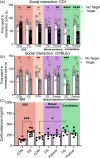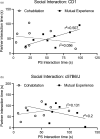Social Buffering is Dependent on Mutual Experience in Adolescent Male Mice Exposed to Social Defeat Stress
- PMID: 35874910
- PMCID: PMC9305802
- DOI: 10.1177/24705470221111094
Social Buffering is Dependent on Mutual Experience in Adolescent Male Mice Exposed to Social Defeat Stress
Abstract
Background: Individuals who experience emotional, physical, or sexual abuse as children suffer from higher rates of major depressive disorder, drug abuse, and suicide. Early life interventions such as peer support groups can be beneficial to adolescents who experience trauma, suggesting that social support is important in facilitating rehabilitation and promoting resiliency to stress. Although there are some animal paradigms that can model how peer-peer interactions influence stress-reactivity, less is known about how individual stress experiences influence the effectiveness of social buffering.
Methods: The vicarious social defeat stress (VSDS) paradigm allows for the assessment of two different stress modalities, physical (PS) and emotional (ES) stress, which confer different levels of stress with similar biological and behavioral outcomes. Using a modified VSDS paradigm in which pairs of mice experience ES and PS together we can begin to evaluate how stress exposure influences the buffering efficacy of social relationships. Adolescent mice (postnatal day 35) were randomly combined into dyads and were allocated into either mutual experience or cohabitation pairs. Within each dyad, one mouse was assigned to the physically stressed (PS) condition and was repeatedly exposed to an aggressive CD1 mouse while the other mouse was designated as the partner. In the mutual experience dyads the partner mice witnessed the defeat bout (ES) while in the cohabitation dyads the partner was separated from the PS mouse and returned after the 10 min defeat bout was terminated (non-stressed). After 10 days of defeat, mice were tested in the social interaction test (SIT), the elevated plus maze (EPM), and the forced swim test (FST).
Results: PS-exposed mice in the cohabitation dyads, but not those in the mutual experience dyads, showed significantly more avoidance of a novel CD1 aggressor or c57BL/6 mouse, in the SIT. Surprisingly, both partner conditions showed avoidance to a CD1. Interestingly, non-stressed partner mice spent less time in the open arms of the EPM, suggesting increased anxiety; only PS-exposed mice in cohabitation dyads showed more time spent immobile in the FST, indicative of increased learned helplessness.
Conclusions: These data suggest that the efficacy of social buffering can be mediated by individual stress experience.
Keywords: adolescence; chronic social defeat stress; social buffering; stress; stress transmission; vicarious social defeat stress.
© The Author(s) 2022.
Figures




Similar articles
-
Nicotine treatment buffers negative behavioral consequences induced by exposure to physical and emotional stress in adolescent male mice.Psychopharmacology (Berl). 2020 Oct;237(10):3125-3137. doi: 10.1007/s00213-020-05598-6. Epub 2020 Jun 27. Psychopharmacology (Berl). 2020. PMID: 32594187 Free PMC article.
-
The effects of emotional stress are not identical to those of physical stress in mouse model of social defeat stress.Neurosci Res. 2020 Sep;158:56-63. doi: 10.1016/j.neures.2019.10.008. Epub 2019 Oct 16. Neurosci Res. 2020. PMID: 31628971
-
Vicarious social defeat stress: Bridging the gap between physical and emotional stress.J Neurosci Methods. 2016 Jan 30;258:94-103. doi: 10.1016/j.jneumeth.2015.10.012. Epub 2015 Nov 3. J Neurosci Methods. 2016. PMID: 26545443 Free PMC article.
-
Can I Get a Witness? Using Vicarious Defeat Stress to Study Mood-Related Illnesses in Traditionally Understudied Populations.Biol Psychiatry. 2020 Sep 1;88(5):381-391. doi: 10.1016/j.biopsych.2020.02.004. Epub 2020 Feb 18. Biol Psychiatry. 2020. PMID: 32228871 Free PMC article. Review.
-
The contagion of social defeat stress: Insights from rodent studies.Neurosci Biobehav Rev. 2020 Apr;111:12-18. doi: 10.1016/j.neubiorev.2020.01.011. Epub 2020 Jan 10. Neurosci Biobehav Rev. 2020. PMID: 31931035 Review.
Cited by
-
Effects of a True Prophylactic Treatment on Hippocampal and Amygdala Synaptic Plasticity and Gene Expression in a Rodent Chronic Stress Model of Social Defeat.Int J Mol Sci. 2023 Jul 7;24(13):11193. doi: 10.3390/ijms241311193. Int J Mol Sci. 2023. PMID: 37446371 Free PMC article.
-
Early life stress and altered social behaviors: A perspective across species.Neurosci Res. 2025 Feb;211:65-74. doi: 10.1016/j.neures.2023.11.005. Epub 2023 Nov 20. Neurosci Res. 2025. PMID: 37992997 Free PMC article. Review.
References
-
- Waldinger RJ, Vaillant GE, Orav EJ. Childhood sibling relationships as a predictor of major depression in adulthood: a 30-year prospective study. Am J Psychiat. 2007;164(6):949–954. - PubMed
-
- Spear LP. The adolescent brain and age-related behavioral manifestations. Neurosci Biobehav Rev. 2000;24(4):417–463. - PubMed
-
- Haney SB. Siblings are also at risk for abuse. Pediatrics. 2021;147(5):e2021049930. - PubMed
LinkOut - more resources
Full Text Sources
Miscellaneous

